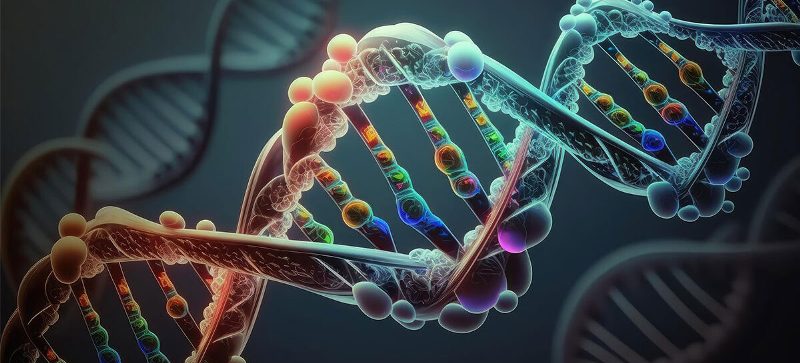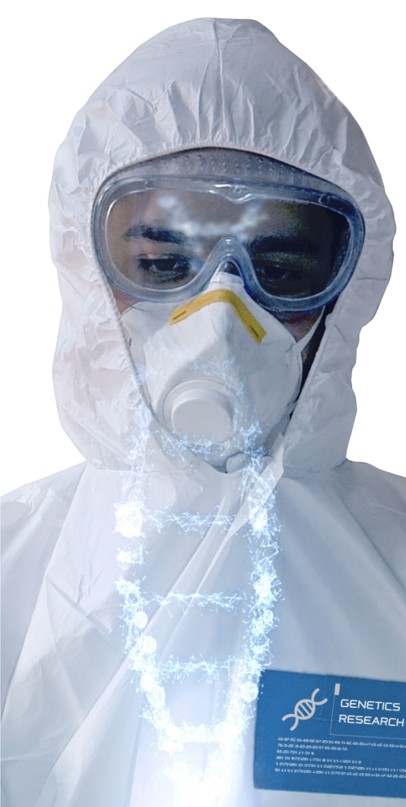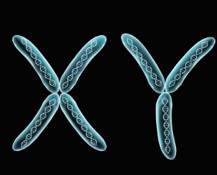
Think about the following questions.
1. What is a genetic trait that is common among people in your family?
2. Are you worried about genetic research? Why or why not?
3. Should governments use public funds for genetic research?
VOCABULARY PREVIEW
Match each New Academic Word List(NAWL) word with the correct definition.
- defect _____
- reproduce _____
- manipulation _____
- cloning _____
- prevalence _____
- genetics _____
- a. to copy; to make again
- b. creating a genetically identical copy of an organism
- c. a flaw, problem, or inconsistency
- d. the act of moving or changing something with your hands or with a machine
- e. the scientific study of genes and their effects on variation
- f. the quality or state of being common or widespread
GENE THERAPY

The field of molecular genetics is progressing at a rapid pace, with our ability to manipulate genes and understand the complex processes involved in genetics developing on an almost daily basis. Understandably, people have fears about this powerful technology and are worried that we may use it in ways to change our humanity. In particular, gene therapy is one aspect of molecular genetics that is causing a lot of concern.
Gene therapy is defined as a way of curing or preventing disease by changing the behavior of a person's genes. Currently, gene therapy is still in its early stages, with most of it still experimental. There are actually two types of gene therapy: somatic and germline. Somatic gene therapy targets genes in the soma, or body cells. In this way, the genome1 of the recipient2 is changed, but this change is not passed on to the next generation. For example, experimental trials in treating cystic fibrosis3 treat the genes only in the cells of the lungs, and, consequently, the patient's children would still be at risk of the disease. In germline gene therapy, genetic changes are made to reproductive cells. The egg or sperm cells of the patient are genetically changed with the goal of passing on these changes to his or her children. In practice, this would mean changing the fertilized egg-the embryo4 — so that the genetic changes would be reproduced in every cell of the future adult, including the reproductive cells. In fact, the use of germline genetic engineering on human embryos is illegal in most countries. Thus far, the procedures are still deemed too risky. Nevertheless, scientists continue to experiment on mice and other animals in order to observe the effects of the treatment and to better understand gene functions more generally.
Many people falsely assume that germline genetic engineering is already performed all the time, due to news reports about genetic manipulation. But in fact, most of these reports are either of somatic gene therapy trials or of cloning, which in itself does not alter any genes but merely copies them. Furthermore, even in the field of somatic gene therapy, many factors have prevented researchers from developing successful therapeutic techniques.
The first problem is in the gene delivery tool—that is, how a new gene is inserted into the body. Scientists have tried to remove the disease-causing genes and insert healthy genes for therapy instead. Most vehicles used these days are viruses. Although the viruses can be effective, other problems may arise. Often, the body reacts against the virus in an immune and inflammatory5 response. Additionally, the viruses don't always target the intended areas.
Another obstacle to successful gene therapy is our limited understanding of gene function. Scientists don't know all the functions of our genes and only know some of the genes involved in genetic diseases. Also, many of the genes involved in genetic diseases may have more than one function. For example, sickle-cell anemia is a genetic disease that is caused by an error in the gene for hemoglobin, the oxygen-carrying protein in our blood. A child with two copies of this faulty gene will have this disease, but a child with only one copy of the faulty gene will not. The prevalence of this disease is greatest in Africa, where there is also a deadly form of malaria6.
Studies have reported that in areas where malaria is endemic7, children with a single copy of the sickle-cell gene had a survival advantage over children who inherited two healthy genes. They went on to grow up and pass on their genes to their own children, conferring on8 them their resistance to malaria. Initial studies have suggested that the gene that causes the defect in sickle-cell hemoglobin also produces an enzyme that repels plasmodium-the pathogen that causes malaria. The point is that this secondary gene function was discovered quite by accident.
Finally, environmental factors play a pivotal role in the expression of many diseases. This is illustrated in studies with identical twins—two people with identical genes who have not developed the same diseases. Epigenetics is an entire subfield that has been developed to study how factors outside of our DNA can interact with genetic traits. But, as environmental factors are much more difficult to study, progress in epigenetics tends to be slow.
New Academic Word List
- genome 1 : adj. the complete set of genetic material in an organism's cell
- recipient 2 : n. a person who receives something
- cystic fibrosis 3 : n. a genetic lung disease
- embryo 4 : n. a human or animal in the early stages of development before it is born, hatched, etc.
- inflammatory5 : adj. causing the body to become swollen, painful, etc., usually due to injury or infection
- malaria 6 : n. a disease affecting the red blood cells and transmitted by mosquitoes
- endemic7 : adj. belonging or native to a particular people or country
- confer on8 : v. to give to
READING COMPREHENSION
A ‣ Mark each statement as true (T) or false (F) according to the reading.
- Germline gene therapy is more developed than somatic gene therapy.
- True
- False
- Cloning involves changing the genetic makeup of non-reproductive cells.
- True
- False
- Viruses are used in the process of somatic gene therapy.
- True
- False
- The gene for sickle-cell anemia can also cause malaria.
- True
- False
- Epigenetics deals with how non-genetic factors can affect our gene functions.
- True
- False
B ‣ Choose the best answer according to the reading.
- What is the reading mainly about?
- a. The dangers of gene therapy
- b. Current challenges in gene therapy
- c. How gene therapy has cured many diseases
- d. The history of gene therapy
- Which is true about somatic gene therapy?
- a. Laws prevent this kind of research at the moment.
- b. Its benefits will not be inherited by patients' children.
- c. It does not directly affect the patient's genes.
- d. Young children benefit most from it.
- What is the main idea of paragraph 3?
- a. Many people do not realize how common germline therapy is.
- b. People tend to exaggerate the bad effects of germline therapy.
- c. Some people have gotten the wrong idea about germline therapy.
- d. The media has done a lot to popularize germline therapy.
- Which is true about the sickle-cell gene?
- a. It is caused by an excess of hemoglobin.
- b. It was first created by scientists in a lab.
- c. It apparently provides protection from malaria.
- d. It is not usually passed from parents to children.
C ‣ Complete the table of causes and effects.
| Cause | Effect |
| Using 1 _____ as a gene delivery tool | An inflammatory response by the immune system |
| News reports on genetic engineering | People think 2 _____ therapies are common |
| A problem with both genes for hemoglobin | The person suffers from 3 _____ |
SUMMARY
Fill in the blanks with the phrases in the box.
- is environmental
- is illegal
- miss their targets
- incomplete understanding
- shortly after conception
- functions of genes
|
Definition
|
|
Challenge 1: Delivery
|
|
Challenge 2: 4 _____
|
VOCABULARY PRACTICE
Fill in the blanks with the words in the box. Change the form if necessary.
- cloning
- defect
- genetics
- manipulation
- prevalence
- reproduce
- The makers of the car are warning the public about a serious _____ in the braking system.
- Gregor Mendel founded the science of _____ when he discovered that plants inherited traits from their "parents."
- The forger was so bold, he _____ the same painting several times and sold all the fakes in the same city.
- Robotics has allowed surgeons to achieve a much more accurate level of _____ even when working remotely.
- Identical twins are the result of a natural form of _____ .
- The _____ of cheating has increased so much that the professors are holding a meeting about it.
SUPPLEMENTAL READING
Artificial Chromosomes

In an attempt to develop new gene delivery tools, researchers have been experimenting with introducing an extra, artificial human chromosome to the body, which would make forty-seven in all. This chromosome would exist alongside and be independent of our other forty-six chromosomes. Scientists also think that these artificial chromosomes would not be attacked by the body and hence would not cause some of the negative reactions that virus vehicles do.
In fact, Chromos Molecular Systems, a biotech company in Canada, is already producing artificial chromosomes in the hope that this will lead to further advances. Dr. Gyula Hadlaczky, the pioneer of this research at Chromos, makes these artificial chromosomes by modifying normal human chromosomes. The result is called an artificial chromosome-although it was originally created through natural processes-because it is the result of that manipulation.
Although gene therapy is limited at present, Hadlaczky expects these modified chromosomes to have applications in other forms of biotechnology and genetic engineering. One application of this tool may be to alter mammal cells grown in the lab so that they become natural producers of vaccines or other drugs.
Although some critics of genetic engineering fear such technology and think it might lead to mutations and the weakening of living systems, the scientific consensus holds that such general fears are unfounded. And at Chromos, they are optimistic. They point to evidence that their artificial chromosomes do not damage cells and that this is an important step forward in genetic engineering.
Fill in the blanks with information from the reading.
- Geneticists are developing artificial chromosomes to act as a(n) _____ tool.
- Scientists are hopeful that artificial chromosomes would not _____ by the body's immune system.
- Scientists could grow and alter _____ in the lab to produce vaccines and other drugs.

Leave a comment
Load more